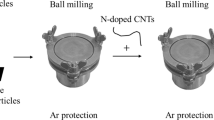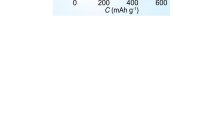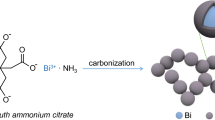Abstract
Hard carbon derived from bamboo for the anode material of sodium-ion batteries has a three-dimensional (3D) open framework structure and has naturally incorporated K-ions into its carbon structure, increasing the d-interlayer spacing of hard carbon materials for facilitating Na+ transport. In this work, bamboo-derived hard carbon was prepared via two carbonization temperatures at 700 and 1000 °C for an hour and employed as an anode for sodium-ion batteries (SIB). X-ray diffraction (XRD) and Fourier transform (FT)-Raman spectroscopic results indicated the disordered structure with d-spacing (d002) around 0.36–0.37 nm, which is a benefit for sodium ion insertion/desertion. Herein, the composition between carbon-nanotube (CNT) and bamboo-derived hard carbon (BB) was synthesized by a ball mill with various contents of CNT (1 wt%, 5 wt% and 10 wt%). At the optimal CNT content of 5 wt%, the sample exhibited excellent performance and outstanding stability. As the anode, the half-cell SIB using BB(700)w@5%CNT (with a carbonization temperature of 700 °C and CNT loading of 5 wt%) delivered a high initial specific capacity of 268.9 mAh·g−1 at 0.1C and capacity retention of 78.6% after 500 cycles at 1.0C. The full cell SIB fabrication BB(700)w@5%CNT in combination with Na3V2(PO4)3 as the cathode demonstrated a high specific capacity of 127.6 mAh·g−1 at 0.2C with its capacitive retention remaining of 78% at 1.0C after 1000 cycles. The attained storage performance indicates that hard carbon-CNT composite anode material enhanced the conductive path of electron transport and provided long-term cycling stability. The good electrochemical performance as well as the low cost and environment-friendliness of the bamboo-derived hard carbon proves its suitability for future sodium-ion batteries.
Graphical abstract











Similar content being viewed by others
References
Larry Elliott, The Guardian. BP Energy Outlook 2035: World Energy Demand to Rise by Almost 40%. Net Zero Watch 2015. https://www.netzerowatch.com/reality-check-world-energy-demand-to-rise-by-almost-40/
U.S. Energy Information Administration (EIA), International Energy Outlook 2021. Department of Energy Washington, DC 20585. 2021. https://www.eia.gov/outlooks/ieo/consumption/sub-topic-01.php
Hall PJ, Bain EJ. Energy-storage technologies and electricity generation. Energy Policy. 2008;36(12):4352. https://doi.org/10.1016/j.enpol.2008.09.037.
Yang Z, Zhang J, Kintner-Meyer MCW, Lu X, Choi D, Lemmon JP, Liu J. Electrochemical energy storage for green grid. Chem Rev. 2011;111(5):3577. https://doi.org/10.1021/cr100290v.
Mahmud S, Rahman M, Kamruzzaman M, Ali MO, Emon MSA, Khatun H, Ali MR. Recent advances in lithium-ion battery materials for improved electrochemical performance: a review. Results Eng. 2022;15:100472. https://doi.org/10.1016/j.rineng.2022.100472.
Wakihara M. Recent developments in lithium ion batteries. Mater Sci Eng R Rep. 2001;33(4):109. https://doi.org/10.1016/S0927-796X(01)00030-4.
Bruce PG, Scrosati B, Tarascon JM. Nanomaterials for rechargeable lithium batteries. Angew Chem Int Ed Engl. 2008;47(16):2930. https://doi.org/10.1002/anie.200702505.
Pan H, Hu YS, Chen L. Room-temperature stationary sodium-ion batteries for large-scale electric energy storage. Energy Environ Sci. 2013;6(8):2338. https://doi.org/10.1039/C3EE40847G.
Zu CX, Li H. Thermodynamic analysis on energy densities of batteries. Energy Environ Sci. 2011;4(8):2614. https://doi.org/10.1039/C0EE00777C.
Kundu D, Talaie E, Duffort V, Nazar LF. The emerging chemistry of sodium ion batteries for electrochemical energy storage. Angew Chem Int Ed Engl. 2015;54(11):3431. https://doi.org/10.1002/anie.201410376.
Raccichini R, Varzi A, Passerini S, Scrosati B. The role of graphene for electrochemical energy storage. Nat Mater. 2015;14(3):271. https://doi.org/10.1038/nmat4170.
Hwang JY, Myung ST, Sun YK. Sodium-ion batteries: present and future. Chem Soc Rev. 2017;46(12):3529. https://doi.org/10.1039/C6CS00776G.
Dou X, Hasa I, Saurel D, Vaalma C, Wu L, Buchholz D, Bresser D, Komaba S, Passerini S. Hard carbons for sodium-ion batteries: structure, analysis, sustainability, and electrochemistry. Mater Today. 2019;23:87. https://doi.org/10.1016/j.mattod.2018.12.040.
Mauger A, Julien CM. State-of-the-art electrode materials for sodium-ion batteries. Materials. 2020;13(16):3453. https://doi.org/10.3390/ma13163453.
Tapia-Ruiz N, Armstrong AR, Alptekin H, Amores MA, Au H, Barker J, Boston R, Brant WR, Brittain JM, Chen Y, Chhowalla M, Choi YS, Costa SIR, Ribadeneyra MC, Cussen SA, Cussen EJ, David WIF, Desai AV, Dickson SAM, Eweka EI, Forero-Saboya JD, Grey CP, Griffin JM, Gross P, Hua X, Irvine JTS, Johansson P, Jones MO, Karlsmo M, Kendrick E, Kim E, Kolosov OV, Li Z, Mertens SFL, Mogensen R, Monconduit L, Morris RE, Naylor AJ, Nikman S, O’Keefe CA, Ould DMC, Palgrave RG, Poizot P, Ponrouch A, Renault S, Reynolds EM, Rudola A, Sayers R, Scanlon DO, Sen S, Seymour VR, Silván B, Sougrati MT, Stievano L, Stone GS, Thomas CI, Titirici MM, Tong J, Wood TJ, Wright DS, Younesi R. 2021 roadmap for sodium-ion batteries. J Phys Energy. 2021;3(3):031503. https://doi.org/10.1088/2515-7655/ac01ef.
Mukherjee S, Bin Mujib S, Soares D, Singh G. Electrode materials for high-performance sodium-ion batteries. Materials. 2019;12(12):1952. https://doi.org/10.3390/ma12121952.
Alvira D, Antorán D, Manyà JJ. Plant-derived hard carbon as anode for sodium-ion batteries: a comprehensive review to guide interdisciplinary research. Chem Eng J. 2022;447:137468. https://doi.org/10.1016/j.cej.2022.137468.
Zhao H, Qi J, Tang X, Zhang K, Teng J, Ding H, Tao Q, Li J. Effect of crown ether additive on the compatibility of electrolyte and hard carbon anode in sodium ion battery. J Alloys Compd. 2023;948:169823. https://doi.org/10.1016/j.jallcom.2023.169823.
Wang J, Zhao J, He X, Qiao Y, Li L, Chou SL. Hard carbon derived from hazelnut shell with facile HCl treatment as high-initial-coulombic-efficiency anode for sodium ion batteries. Sustain Mater Technol. 2022;33:e00446. https://doi.org/10.1016/j.susmat.2022.e00446.
Zhang Y, Li J, Ma L, Li H, Xu X, Liu X, Lu T, Pan L. Insights into the storage mechanism of 3D nanoflower-like V3S4 anode in sodium-ion batteries. Chem Eng J. 2022;427:130936. https://doi.org/10.1016/j.cej.2021.130936.
Li J, Ding Z, Pan L, Li J, Wang C, Wang G. Facile self-templating synthesis of layered carbon with N, S dual doping for highly efficient sodium storage. Carbon. 2021;173:31. https://doi.org/10.1016/j.carbon.2020.10.092.
Zhang X, Zhu G, Wang M, Li J, Lu T, Pan L. Covalent-organic-frameworks derived N-doped porous carbon materials as anode for superior long-life cycling lithium and sodium ion batteries. Carbon. 2017;116:686. https://doi.org/10.1016/j.carbon.2017.02.057.
Zhu H, Li Z, Xu F, Qin Z, Sun R, Wang C, Lu S, Zhang Y, Fan H. Ni3Se4@CoSe2 hetero-nanocrystals encapsulated into CNT-porous carbon interpenetrating frameworks for high-performance sodium ion battery. J Colloid Interface Sci. 2022;611:718. https://doi.org/10.1016/j.jcis.2021.11.175.
Lin R, Xu Y, Xiao M, Du W, Zhu F, Meng Y. In-situ pyrolysis preparation of Fe3O4@CNTs/CC as binder-free anode for sodium-ion batteries. Mater Chem Phys. 2023;297:127403. https://doi.org/10.1016/j.matchemphys.2023.127403.
Shao W, Shi H, Jian X, Wu ZS, Hu F. Hard-carbon anodes for sodium-ion batteries: recent status and challenging perspectives. Adv Energy Sustain Res. 2022;3(7):2200009. https://doi.org/10.1002/aesr.202200009.
Hasa I, Mariyappan S, Saurel D, Adelhelm P, Koposov A, Masquelier C, Croguennec L, Casas-Cabanas M. Challenges of today for Na-based batteries of the future: from materials to cell metrics. J Power Sources. 2021;482:228872. https://doi.org/10.1016/j.jpowsour.2020.228872.
Liu C, Chu J, Liu Y, Lyu Y, Guo B. The synergistic effect of carbon coating and CNTs compositing on the hard carbon anode for sodium ion batteries. RSC Adv. 2019;9(38):21667. https://doi.org/10.1039/C9RA04251B.
Feng S, Chen J, Niu X, Feng X, Zhao J. Coaxial hard carbon-coated carbon nanotubes as anodes for sodium-ion batteries. Chem Nano Mater. 2022;8(10):e202200348. https://doi.org/10.1002/cnma.202200348.
Feng J, Dong L, Li X, Li D, Lu P, Hou F, Liang J, Dou SX. Hierarchically stacked reduced graphene oxide/carbon nanotubes for as high performance anode for sodium-ion batteries. Electrochim Acta. 2019;302:65. https://doi.org/10.1016/j.electacta.2019.02.008.
Suo L, Zhu J, Shen X, Wang Y, Han X, Chen Z, Li Y, Liu Y, Wang D, Ma Y. Hard carbon spheres interconnected by carbon nanotubes as high-performance anodes for sodium-ion batteries. Carbon. 2019;151:1. https://doi.org/10.1016/j.carbon.2019.05.030.
Hou H, Qiu X, Wei W, Zhang Y, Ji X. Carbon anode materials for advanced sodium-ion batteries. Adv Energy Mater. 2017;7(24):1602898. https://doi.org/10.1002/aenm.201602898.
Damodar D, Ghosh S, Usha Rani M, Martha SK, Deshpande AS. Hard carbon derived from sepals of Palmyra palm fruit calyx as an anode for sodium-ion batteries. J Power Sources. 2019;438:227008. https://doi.org/10.1016/j.jpowsour.2019.227008.
Li Y, Li B, Zhang X, Chen L, Zhang Q, Wang T, Ma L. Continuous pyrolysis and catalytic upgrading of corncob hydrolysis residue in the combined system of auger reactor and downstream fixed-bed reactor. Energy Convers Manag. 2016;122:1. https://doi.org/10.1016/j.enconman.2016.05.055.
Liu P, Li Y, Hu Y-S, Li H, Chen L, Huang X. A waste biomass derived hard carbon as a high-performance anode material for sodium-ion batteries. J Mater Chem A. 2016;4(34):13046. https://doi.org/10.1039/C6TA04877C.
Yang Y, Tang DM, Zhang C, Zhang Y, Liang Q, Chen S, Weng Q, Zhou M, Xue Y, Liu J. “Protrusions” or “holes” in graphene: which is the better choice for sodium ion storage? Energy Environ Sci. 2017;10(4):979. https://doi.org/10.1039/C7EE00329C.
Chen C, Huang Y, Meng Z, Zhang J, Lu M, Liu P, Li T. Insight into the rapid sodium storage mechanism of the fiber-like oxygen-doped hierarchical porous biomass derived hard carbon. J Colloid Interface Sci. 2021;588:657. https://doi.org/10.1016/j.jcis.2020.11.058.
Cao Y, Xiao L, Sushko ML, Wang W, Schwenzer B, Xiao J, Nie Z, Saraf LV, Yang Z, Liu J. Sodium ion insertion in hollow carbon nanowires for battery applications. Nano Lett. 2012;12(7):3783. https://doi.org/10.1021/nl3016957.
Lai F, Zhou G, Li F, He Z, Yong D, Bai W, Huang Y, Tjiu WW, Miao YE, Pan B, Liu T. Highly dual-heteroatom-doped ultrathin carbon nanosheets with expanded interlayer distance for efficient energy storage. ACS Sustain Chem Eng. 2018;6(3):3143. https://doi.org/10.1021/acssuschemeng.7b03161.
Irisarri E, Ponrouch A, Palacin M. Review—hard carbon negative electrode materials for sodium-ion batteries. J Electrochem Soc. 2015;162:A2476. https://doi.org/10.1149/2.0091514jes.
Beda A, Le Meins J-M, Taberna P-L, Simon P, Matei Ghimbeu C. Impact of biomass inorganic impurities on hard carbon properties and performance in Na-ion batteries. Sustain Mater Technol. 2020;26:e00227. https://doi.org/10.1016/j.susmat.2020.e00227.
Wang Z, Qie L, Yuan L, Zhang W, Hu X, Huang Y. Functionalized N-doped interconnected carbon nanofibers as an anode material for sodium-ion storage with excellent performance. Carbon. 2013;55:328. https://doi.org/10.1016/j.carbon.2012.12.072.
Fu L, Tang K, Song K, van Aken PA, Yu Y, Maier J. Nitrogen doped porous carbon fibres as anode materials for sodium ion batteries with excellent rate performance. Nanoscale. 2014;6(3):1384. https://doi.org/10.1039/c3nr05374a.
Zhong X, Wu Y, Zeng S, Yu Y. Carbon and carbon hybrid materials as anodes for sodium-ion batteries. Chem Asian J. 2018;13:1248. https://doi.org/10.1002/asia.201800132.
Xiao L, Cao Y, Henderson WA, Sushko ML, Shao Y, Xiao J, Wang W, Engelhard MH, Nie Z, Liu J. Hard carbon nanoparticles as high-capacity, high-stability anodic materials for Na-ion batteries. Nano Energy. 2016;19:279. https://doi.org/10.1016/j.nanoen.2015.10.034.
Chandra M, Khan TS, Shukla R, Ahamad S, Gupta A, Basu S, Haider MA, Dhaka RS. Diffusion coefficient and electrochemical performance of NaVO3 anode in Li/Na batteries. Electrochim Acta. 2020;331:135293. https://doi.org/10.1016/j.electacta.2019.135293.
Sheng J, Yang L, Zhu YE, Li F, Zhang Y, Zhou Z. Oriented SnS nanoflakes bound on S-doped N-rich carbon nanosheets with a rapid pseudocapacitive response as high-rate anodes for sodium-ion batteries. J Mater Chem A. 2017;5(37):19745. https://doi.org/10.1039/C7TA06577A.
Hu Z, Zhu Z, Cheng F, Zhang K, Wang J, Chen C, Chen J. Pyrite FeS2 for high-rate and long-life rechargeable sodium batteries. Energy Environ Sci. 2015;8(4):1309. https://doi.org/10.1039/C4EE03759F.
Hu X, Sun X, Yoo SJ, Evanko B, Fan F, Cai S, Zheng C, Hu W, Stucky GD. Nitrogen-rich hierarchically porous carbon as a high-rate anode material with ultra-stable cyclability and high capacity for capacitive sodium-ion batteries. Nano Energy. 2019;56:828. https://doi.org/10.1016/j.nanoen.2018.11.081.
Han Y, Lu Y, Shen S, Zhong Y, Liu S, Xia X, Tong Y, Lu X. Enhancing the capacitive storage performance of carbon fiber textile by surface and structural modulation for advanced flexible asymmetric supercapacitors. Adv Funct Mater. 2019;29(7):1806329. https://doi.org/10.1002/adfm.201806329.
Li L, Peng S, Lee JKY, Ji D, Srinivasan M, Ramakrishna S. Electrospun hollow nanofibers for advanced secondary batteries. Nano Energy. 2017;39:111. https://doi.org/10.1016/j.nanoen.2017.06.050.
Wang Q, Zhu X, Liu Y, Fang Y, Zhou X, Bao J. Rice husk-derived hard carbons as high-performance anode materials for sodium-ion batteries. Carbon. 2018;127:658. https://doi.org/10.1016/j.carbon.2017.11.054.
Acknowledgements
The authors would like to acknowledge the National Science and Technology Development Agency (NSTDA), Development of cost effective and high cyclability rechargeable zinc-ion battery (P1950722) and study of flared gas-based CNT electrodes in various energy storage (P2052076) for instruments and financial support. This work has been facilitated by Hideki Nakajima as the beamline manager of the Synchrotron Light Research Institute in Thailand. Moreover, this research has received partial funding support from the NSRF via the Program Management Unit for the Human Resources & Institutional Development, Research, and Innovation (PMU-B), in the Industrial Postdoctoral Research Fellowship Program to support Thailand Strategic Industry (No. B01F640054) that was carried out as a part of the requirement for the Postdoctoral Fellowship Program of Dr. Sukanya Pothaya in NSTDA, Thailand.
Author information
Authors and Affiliations
Corresponding authors
Ethics declarations
Conflict of interests
The authors declare that they have no conflict of interest.
Supplementary Information
Below is the link to the electronic supplementary material.
Rights and permissions
Springer Nature or its licensor (e.g. a society or other partner) holds exclusive rights to this article under a publishing agreement with the author(s) or other rightsholder(s); author self-archiving of the accepted manuscript version of this article is solely governed by the terms of such publishing agreement and applicable law.
About this article
Cite this article
Pothaya, S., Poochai, C., Tammanoon, N. et al. Bamboo-derived hard carbon/carbon nanotube composites as anode material for long-life sodium-ion batteries with high charge/discharge capacities. Rare Met. 43, 124–137 (2024). https://doi.org/10.1007/s12598-023-02414-w
Received:
Revised:
Accepted:
Published:
Issue Date:
DOI: https://doi.org/10.1007/s12598-023-02414-w




